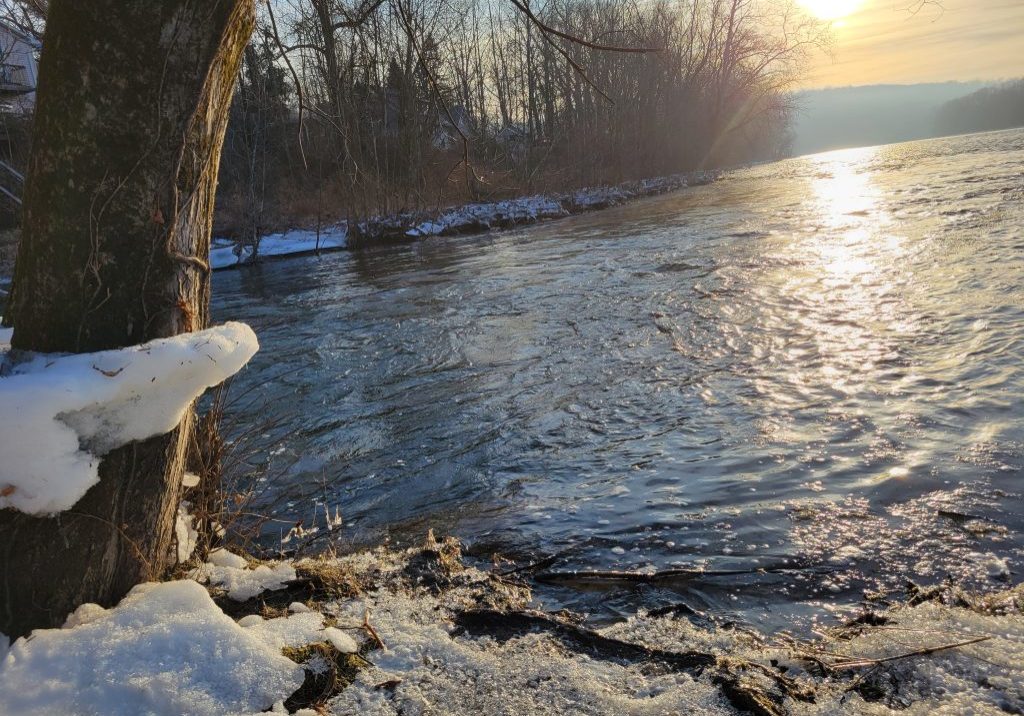
How did the flow from the Delaware River reservoirs become “flexible”?
| May 18, 2023
If you want to really understand the Delaware River, you’ve got to get your arms around the Flexible Flow Management Program — the agreement among the five decree parties about how much water New York City can “keep” of its headwaters and how much it should release.
The thing is, if people know about the FFMP at all, it’s considered one of those “Upper River” things, and it’s wicked complicated to boot, so even if you do recognize its importance basin-wide, you might think there are better things to understand about our river.
There really isn’t.
One of the professional engineers from the Delaware River Basin Commission offered a master class in the what and why (and where and how) for the Coalition for the Delaware River Watershed with help from the Friends of the Upper Delaware River in a webinar last week.
Amy Shallcross is manager of water resource operations for the DRBC, and is steeped in all things water. She was our guide to the FFMP, as it’s known.
Even though the class was presented by Shallcross, one of the first things to understand is that the DRBC doesn’t monitor the program. The Office of the Delaware River Master monitors compliance with it.
The FFMP really has its roots in the construction of the three reservoirs that capture the headwaters of the Delaware. In order of construction, they are: Neversink (completed 1954), Pepacton (completed 1955), and Cannonsville (completed 1964).
But well before there were these reservoirs, the New York City Board of Water Supply approved their construction in 1927.
Shortly thereafter in 1931, New Jersey sued New York City and New York State. (Pennsylvania intervened.) When states argue, the dispute goes to the Supreme Court of the United States.
New Jersey and Pennsylvania were concerned, maybe even alarmed, that New York City would take so much water that there wouldn’t be enough for the cities and towns downriver in both states. Managing the water from the reservoirs is a whole-basin enterprise.
In its 1931 decree, the Supreme Court set flow targets for the river for Port Jervis, N.Y., and Trenton, N.J., and limited how much New York City could take out of the system.
The states still felt there were some negative impacts, so once again the U.S. Supreme Court stepped in (1954) and eliminated the Trenton objective and set the flow objective at Montague, N.J., at 1750cfs. The diversion for New Jersey was set at 100 mgd.
New York City’s diversion was limited to 800 mgd when the reservoirs were completed and this decree established a River Master, a sort of neutral party to keep the parties honest under the wing of the United States Geological Survey.
There’s an important difference between the parties in the Delaware River Basin Commission — the governors of the four states (New York, New Jersey, Pennsylvania and Delaware) and the federal government (represented by the United States Army Corps of Engineers) — and the decree parties (called the decree parties as they are all parties to the U.S. Supreme Court decrees).
In fact, the DRBC wasn’t created until 1961, after these decisions. This was also after the devastating floods of 1955, and around the time that the Tocks Island dam was still under consideration.
The compact that created the DRBC also wanted it to be a way for the states to cooperate to address the possibility of water-supply shortages as well as to address the severe pollution in the main stem and its tributaries.
The decree parties are once again the four states but there’s no federal representative. Instead, New York City is one of the decree parties. The decree parties are authorized to change provisions of the 1954 decree but only with the unanimous consent of all five parties.
The need for a balance among all the states was emphasized in the severe drought that hit this region and lasted from 1962 to 1967.
Battling the salt line
During that drought, the famous salt front takes center stage.
The Delaware opens onto the Atlantic Ocean and is tidal up to Trenton. Most years, the salt line is repelled by the push of fresh water from upriver. That push is not just the waters from the reservoirs, but from all the rivers and streams that empty into the Delaware, like the Lackawaxen, the Lehigh, the Musconetcong, and except in times of severe drought, the Schuylkill.
In the ’60s, the drought meant there wasn’t enough water to push the salt front away, so it reached about eight miles south of Philadelphia’s drinking water intakes (above the mouth of the Schuylkill). These days we also have to protect the intakes of New Jersey American Water.
The salty water would corrode water pipes, it would have negative health impacts, it would hamper industrial processes and it would taste odd.
More work to determine appropriate allocations were developed in the Good Faith Agreement in 1981. This establishes alterations to the basic SCOTUS decree, including reductions in flow targets, diversions and releases to conserve water during droughts. It also planted the seed that developed the idea that the “flow” could be flexible to suit conditions on the ground and not just a one-size-fits all set of rules.
Around this time, with the completion of the reservoirs, anglers realized that the habitats of the waters below the dams were changing. It was becoming an ideal place for trout, which thrive in cold clear water, just like the water coming from the releases from the reservoirs.
In 2007-08, the Flexible Flow Management Program was adopted. Peter Kolesar and Jim Serio are credited with doing the heavy lifting to get the FFMP organized and it’s not surprising that the task needed Kolesar’s background in statistics.
Over time, more and more fine-tuning was applied to the 2007-8 document to develop thermal mitigation, rapid flow mitigation, a dedicated bank for the Trenton flow objective and New Jersey diversion amelioration.
The FFMP was set up to be renewed every five years, though intermittent changes were adopted.
And about now, the notion that the Flexible Flow Management Program was strictly developed for anglers started to take hold but if you look at the document that ushered in the program, from 2007, you can see plenty of broader impacts, most important of which is the commitment to ensure the salt front is pushed away from the various intakes around Philadelphia.
The pull and push of various agendas has always been a part of the management of the reservoir releases and when it came time for the FFMP to be renewed in 2017, there was some concern that it might not happen.
Despite the contention, the FFMP was renewed, and this time for 10 years, but in two parts. The first set of five years was to develop studies about, among other things, releases to repel the salt front as well as increase diversions.
The first five years has passed but the studies weren’t completed mostly due to Covid, so the 2017 FFMP has been renewed, largely unchanged.
Additionally, the Coalition for the Delaware Watershed, which sponsored this webinar, has adopted the FFMP as one of its “watershed-wide policy priorities,” helping to broaden understanding that what affects the upper basin will soon enough affect the rest of the basin.
Here are some stories from Delaware Currents that capture some of those conflicting agendas:






